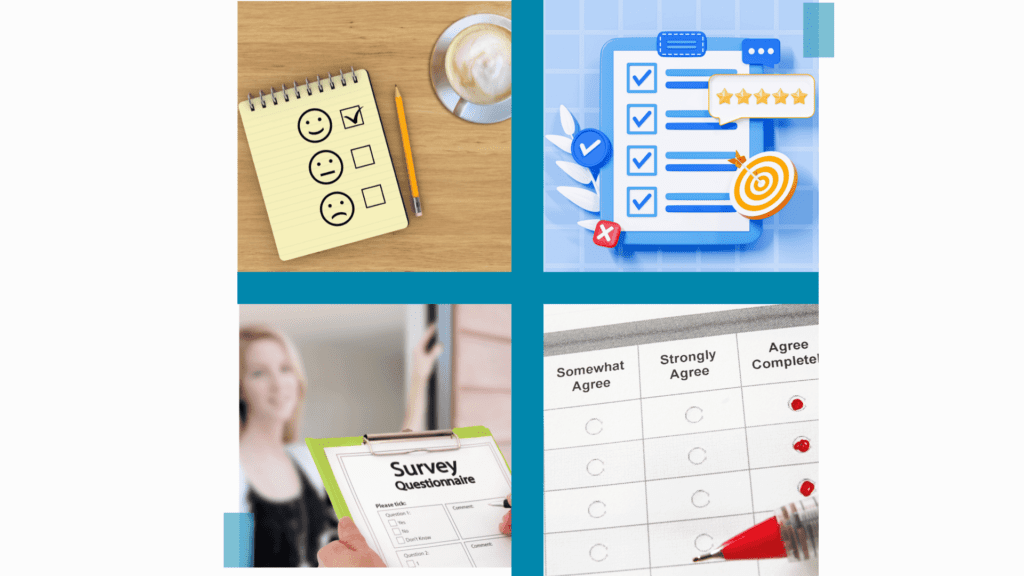Last Updated: September 25, 2023
Do you know that..
What’s the point of membership surveys for organizations, and how can they help both the organization and its members?
Member surveys are very helpful for groups that want to learn more about and connect with their members.
These surveys are an important way for communities to get feedback, ideas, and preferences from their members. This helps them make smart choices and change their plans to meet the wants and demands of their members.
It’s impossible to say enough good things about membership surveys, which help organizations in many ways and make people feel like they belong.
📚 Why You Should Read This? 📚
Curious about what a membership survey is? We’ll decode their secrets, explaining how and why they’re used, so you can make the most of them.
We are ready to expose you to everything you wonder about the member surveys, please keep scrolling!
🔑 Key Points We’ll Explore:
- Why Conduct a Membership Survey
- Planning Your Membership Survey
- Crafting Effective Membership Survey Questions
- Member Surverys for Member Engagement and Satisfaction
- Analyzing Membership Survey Data
- Example of Successful Membership Surveys
- Bonus Free Membership Survey Templates
💡 Why are the benefits of Member Survey?

Benefit #1: Enhanced Member Engagement
Effective member surveys show that a group cares about hearing what its members have to say. This kind of involvement builds trust and a sense of community, which makes people more likely to take part in activities and make a positive impact.
Benefit #2: Informed Decision-Making
Online survey gives groups information based on numbers about what their members care about the most. With this information, they can make better choices about programs, services, and projects that are in line with what members want.
Benefit #3: Improved Member Retention
When groups know what their members want and need, they can deal with problems before they happen and make changes that make members happier. In turn, this makes members more loyal and lowers the rate at which they leave.
Benefit #4: Tailored Offerings
Survey questions help businesses tailor their services to make sure they offer useful and relevant ones. Personalization like this can get members more involved and make them feel like they belong more.
Benefit #5: Strategic Planning
Survey results help with planning for the long run thanks to member feedback. Organizations are able to identify trends, new issues, and growth opportunities, which helps them modify and adapt their plans.
Benefit #6: Resource Allocation
Membership surveys help make good use of resources by putting them where current members think they will be most useful. This improvement makes sure that an organization’s efforts are focused on projects that its members care about.
Benefit #7: Benchmarking and Evaluation
Surveys let businesses see how they’re doing over time and in comparison to other businesses in the same field. This helps keep track of work and see how changes and improvements have affected things.
Benefit #8: Feedback Loop
When a survey program is done right, it creates a feedback loop that keeps people and groups informed. Surveys done on a regular basis start conversations that last and encourage a culture of responsibility and response.
Why Conduct a Membership Survey?
Are you still not sure why surveys are important after reading about their benefits?
All right then,
Membership surveys are a great way for groups to improve how they do things and serve their members better.
Polls like these aren’t just routine ways to collect information; they’re part of a larger plan to learn more about members’ wants, tastes, and views.
There are many good reasons to do a member survey, and the surveys are good for both the groups and the people who belong to them.
1. Member-Centric Focus: Membership surveys put members at the center of how a group makes decisions. By asking for their positive or negative feedback, organizations show that they care about meeting the wants and expectations of their members.
2. Informed Decision-Making: Assessment survey answers give businesses useful information and ideas based on data and member opinions. This huge amount of information lets people make smart choices about many things, like how to build programs, divide up resources, and make long-term members and plans.

3. Enhanced Member Engagement: Members feel respected and involved when they are asked for their thoughts and comments. This involvement makes people feel like they own and belong in the group, which makes members more involved and committed.
4. Improved Member Retention: When organizations know what’s important to their members, they can answer their issues and make the necessary changes. This makes members happier and more loyal, which lowers the rate at which they leave.

5. Customized Offerings: The results of surveys help groups make their services fit the needs of their users. This personalization makes members more likely to participate and makes everyone happier overall.
6. Strategic Alignment: Surveys help organizations make sure that their goals and projects are in line with what their members want. They help companies figure out what the latest trends, problems, and growth opportunities are, so they can change their plans to fit.
7. Efficient Resource Allocation: Organizations can set priorities and use resources wisely by getting comments from members. This makes sure that resources go to the projects that will have the biggest effect on meeting company goals and making members happy.
8. Continuous Improvement: Membership surveys set up a feedback loop between groups and their members that never ends. Regular surveys encourage ongoing dialogue, responsibility, and a mindset of always getting better.

9. Benchmarking and Evaluation: Surveys help businesses figure out how well they’re doing over time and compare it to best practices in the same field. This helps you keep track of your progress and see how well changes and improvements are working.
10. Strengthening the Member-Organization Bond: In the end, membership surveys make the connection between members and organizations stronger. By asking for feedback and acting on it, groups show that they care about what’s best for their members.
Planning Your Membership Survey
Do you know how to plan a successful membership survey?
Don’t worry, we’ve got this for you!
Planning a member survey that works is an important first step to make sure you get useful information.
Here are some important steps to think about:
Set Clear Objectives and Goals: Explain why you are doing the survey. What specific data do you want to collect, and how will it help your group and its members? Having clear goals will help guide the whole study process.
Select a Survey Method: Pick the right type of survey, like an online survey, a phone chat, or a paper survey. Think about what your audience wants and how easy it is for them to get there.
Create a Survey Team: Put together a group that will be in charge of designing, sending out, and analyzing the survey. Assign tasks and jobs to make sure everyone works together well.
Design the Survey: Make sure your questions are well-structured and related to your goals. Make sure that the survey length is short, clear, and simple to use.
Test the Survey: Before going live, test the survey with a small group of people to see if there are any problems with how clear, long, or worded it is.
Set a Timeline: Make a schedule that includes times for start, data collection, and analysis. Tell your team and members about this deadline.
Promote the Survey: Make a plan for how you will let people know about the survey, why it’s important for them to fill it out, and how to do it. Use a variety of platforms to effectively reach your target group.
Collect Data Ethically: Make sure that the way you collect data protects the rights of your users and follows the rules, like GDPR or HIPAA.
Crafting Effective Membership Survey Questions

To get useful information from your audience, you need to make sure your member survey questions are good.
Start with open-ended member survey questions to get specific answers that show how members’ experiences are different.
For example of member satisfaction survey question could be, you could ask, “What do you like most about being a member of our group?”
💡 This lets users say what they want without any restrictions.
In another member satisfaction survey question should use multiple-choice questions with clear answer choices to get specific feedback.
“On a scale of 1 to 5, how satisfied are you with our events?”
💡 This format makes it easy to find trends and measure replies.
Always test your member satisfaction survey questions with a small group of people to make sure they are clear and don’t add any bias.
💡 You can get useful information to improve your membership offers and participation by making well-thought-out survey questions.
More tips about member survey questions:
Keep Questions Concise: Make sure each question is clear and to the point for member satisfaction survey. Don’t use words or hard-to-understand language that could make people confused. Make your words clear and simple.
Avoid Double-Barreled Questions: Asking more than one question in the same sentence is a common mistake. Don’t ask things like, “Do you like our events and website?” The question should be split into two different ones.
Balance with Multiple-Choice Questions: Answers to multiple-choice questions are more organized, which makes them easier to look at quantitatively. Use them to get specific comments on a scale or with choices that have already been set. Say, “How often do you come to our events?” and give answers like “Regularly,” “Occasionally,” “Rarely,” or “Never.”
Member Surveys for Member Engagement and Satisfaction

Membership satisfaction surveys are one of the best ways for communities to get members more involved and make them happier.
Organizations can build stronger relationships with their members and encourage a sense of connection and loyalty in the community by using surveys in a smart way to get feedback, include members in decision-making, and keep making their services better.
You can use these surveys well by following these steps, which also include ways to measure and improve member satisfaction survey:
Step 1: Identifying Member Needs and Preferences
Surveys help you understand your members’ specific requirements and preferences.
You may adjust your activities, services, and messages to their needs by inquiring about their expectations, interests, and preferences.
For instance, “What types of events or benefits would you like to see more of in our membership?”
Step 2: Engaging Members in Decision-Making
Involving members in decision-making may boost ownership and engagement.
Surveys may help choose event subjects, new initiative topics, and community initiatives.
Asking “Which of the following project ideas would you like our organization to prioritize?” involves members in influencing the organization’s direction.
Step 3: Member Satisfaction
Regular gauge membership satisfaction surveys. Ask about member satisfaction survey, membership value, and particular things they like or dislike.
For example, “On a scale of 1 to 5, how satisfied are you with our membership benefits and services?”
Step 4: Monitoring Member Engagement
Surveys may help measure member engagement with your organization.
Questions like “How often do you attend our events?” “Do you engage with our online community?”
Step 5: Collecting Feedback for Continuous Improvement
Membership surveys provide organizations with vital feedback. Ask open-ended questions for feedback and improvements.
Take this feedback to show your dedication to membership satisfaction survey and participation.
Analyzing Membership Survey Data
Membership survey data analysis is essential to translating raw replies into usable information.
You can comprehend your members’ viewpoints, discover patterns, and make educated decisions with proper analysis.
This chapter emphasizes data interpretation and visualization for survey data analysis:
Data Cleaning and Preprocessing
- Clean the data by checking for missing or inconsistent replies.
- To simplify quantitative analysis, assign numerical values to categorical replies
- Data should be organized for analysis.
Descriptive Analysis
- Start with descriptive statistics to summarize. Quantitative questions need mean, median, and standard deviation calculations.
- Create frequency tables for categorical queries to analyze response distribution.
Data Segmentation
- To discover group differences in replies, segment the data by demographics or other factors like age, membership term, and geography.
Data Interpretation
- Compare segments and look for trends and outliers.
- Find crucial information, like high pleasure or discontent.
Data Visualization
- Data visualization makes it easier to comprehend and engage. A chart or graph may rapidly explain complicated facts.
- Bar charts, pie charts, histograms, scatter plots, and line graphs are visualization techniques.
- Color, labels, and titles improve visualization clarity and context.
Key Findings and Recommendations
- Highlight significant results, trends, and insights to summarize your investigation.
- Make recommendations to boost member happiness and engagement based on your analysis.
Data Validation
- Compare survey data to other relevant data sources to verify your conclusions and data veracity.
Report and Share Results
- Give a short report or presentation of your results. Use images to simplify your analysis and reach more people.
- Inform decision-makers and change-implementation team members of the results.
Continuous Improvement
- Save survey data and analysis for future surveys to track changes and improvements.
Examples of Successful Membership Surveys
MemberPress Event Survey
You should directly ask people who use your platform a lot of things. You can really learn what people think about your website or platform by asking them surveys. This will help you figure out what they like and don’t like about it.
For example, you can check member satisfaction survey examples, such as MemberPress’ event survey to learn your members’ thoughts about your last event.

Jotform Membership Survey
Another successful member satisfaction survey examples could be Jotform’s survey.
They create customizable templates for users for everything, such as gym memberships, club memberships, etc.

Bonus Free Membership Survey Templates
If you’re having trouble or are confused about how to do it, don’t worry.
We have prepared free, customizable member satisfaction survey examples for you.
With this template, you can understand how satisfied your members are with your website or the platform you use.
All you have to do is download the free membership survey template with one click!

Last Chapter
It’s time to part.
We’re just kidding, but we are happy to say that you have come to the end of this blog post.
We hope you found every detail you were looking for.
Let’s see what we talked about briefly, shall we? ✨
In short, membership surveys are very useful for groups that want to get closer to their members, get them more involved, and keep making their services better.
Surveys like these build trust and a sense of community by getting people involved in making decisions and getting feedback.
They help groups make smart choices, customize their services, and effectively meet the wants of their members.
Membership surveys can do many useful things, such as increasing member involvement and retention, tailoring services to individual needs, and helping with strategic planning.
They also have a useful feedback process that promotes open communication and a mindset of always getting better.
FAQs about Membership Survey
1-Why conduct a membership survey?
It is used to improve the services and offers offered and to eliminate deficiencies by receiving feedback from members.
2-How long will the survey take to complete?
The survey is designed to be concise and should take approximately 10 minutes to complete, ensuring that your time is respected while still allowing for comprehensive feedback.
3-Is participation in the survey anonymous?
This may change. While some platforms or websites offer the right to be anonymous, some ask for your name, but the healthy thing is to be anonymous.
4-What will the survey results be used for?
The survey results will be used to identify areas for improvement and make informed decisions about how to enhance the membership experience.
5-Can new members participate in the survey?
Unless stated otherwise by the organization, there is no harm in new members joining, in fact, a new perspective would be better for membership-based organizations.







